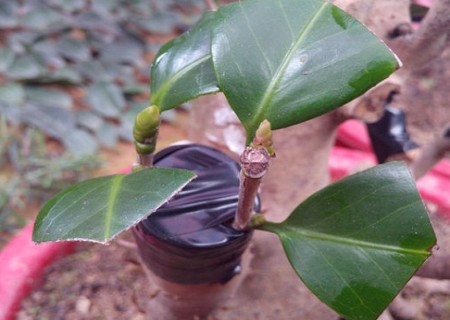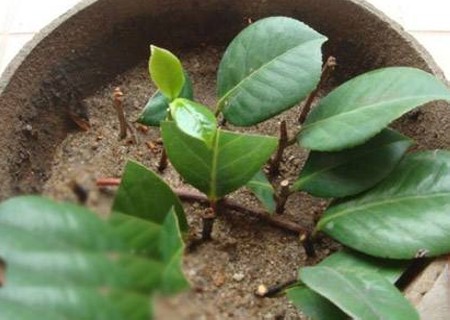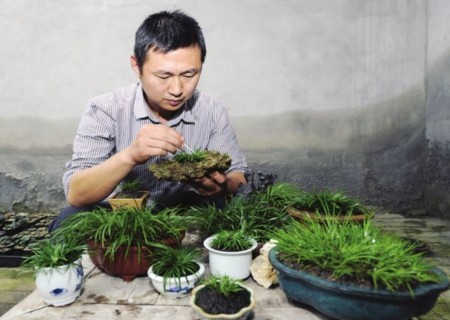Grafting technique of potted tea plum
Many potted flowers and plants can be grafted to breed young plants, and so can tea plum. Although Camellia oleifera can also be bred by grafting, the grafting is more difficult and the survival rate is relatively low. Therefore, in order to improve the success rate of grafting of potted tea plum, we must master the essentials of operation, otherwise it will get half the result with twice the effort and may even lead to failure.

Grafting is a technology, is a meticulous work, to achieve success, naturally must not be careless. In addition to mastering the grafting method, we should also be able to flexibly deal with all kinds of details that may arise. Only in this way can our grafting process be successful. So, how can tea plum be grafted and propagated? Today, the editor is going to talk about the grafting technology of potted tea plum.
I. scion selection
The selection of scions should be based on the right varieties, and varieties with similar plant shape or similar growth should be selected as far as possible, and it is also suggested that different varieties of the same tree species should be selected as cuttings, and more importantly, strong branches must be selected. Only when the above conditions are met, can we provide the basis for improving the success rate of grafting and achieve the expected effect of our grafting.
Second, grafting time
The grafting of tea plum is mostly carried out from May to September, because during this period, the rootstock is very sufficient in nutrient and water absorption, and grows very exuberantly. In this period of time, the selection of robust scions and rootstocks for grafting can improve the success rate and survival rate of grafting. Through practice, it is found that the best time for grafting tea plum is from June to July every year, because the temperature is more suitable during this period, and the scion of tea plum is basically semi-lignified, and the transplanted rootstock seedlings survive completely, so the success rate of grafting is very high.
III. Grafting process
There are many grafting methods of Camellia oleifera, such as peeling grafting, triangular embedding, tender branch grafting and water cutting grafting. However, as a potted plant, tea plum often uses tender branch grafting to propagate and cultivate young trees. This method is to graft the semi-lignified scion branches on the new branches of the rootstocks without semi-Lignification, and the splitting method is usually used to complete the grafting process. The general operation is as follows:
First, split grafting is used to complete the basic grafting steps, then a thick transparent plastic bag is used to cover the grafting site together with the scion, and then a shaded Kraft paper bag or other tools that can achieve the same effect are covered on the outermost layer. in this way, most of the strong light can be obscured and the normal growth conditions are provided for the grafting part. After the grafting survived, the paper bags and plastic bags were removed from the outside to the inside.
When grafting is carried out in this way, because the rootstock and scion are relatively tender branches, their cambium is thicker, the wound produced during grafting can heal more quickly, and the survival rate of the grafted product is higher. It is one of the main methods of tea plum grafting to breed potted young trees, which is more suitable for the majority of potted enthusiasts to try.
IV. Post-management
After the grafted tea plum young trees completely survived, we can not relax in the management, but should make more efforts to improve to ensure that the plant takes shape and has a good ornamental effect. The main management measures focus on the following aspects:
1. Dry cutting treatment
Chamei examined the healing of the wound 1 month after grafting. If it healed well, it is recommended to cut off half or more of the rootstock at 2-3 cm of scion and keep it down properly. Generally, the rootstock should not be truncated directly at this time, because the scion does not have the ability to obtain water and nutrients and needs to be obtained through the rootstock. It is recommended that the axillary buds of the scion should be completely truncated after 2 months.
2. Untie at the right time
When the axillary buds of the scion are fully grown, we can unbind and untie the film used for sealing in the previous grafting, and it will take about 3 weeks for its growth to be stable and strong before the binding can be completely cut off, so as not to hinder its normal growth and development. At this time, it can also gradually add better light conditions for the plant.
3. Remove the sprouts
With the continuous growth of grafted Camellia oleifera, many buds and shoots will sprout on the rootstock, and their growth is very rapid, so they should be removed in time, otherwise it will seriously affect the normal growth of the scion and make the plant grow slowly. hinder the development, resulting in poor growth. In more serious cases, it may cause the plant to become thin and yellow. Because the germination of twigs and buds will take away the nutrients and water of the scion in the competition, and the scion can not get the nutrients and water to meet the growth, there will be a survival crisis.
4. Pruning tree shape
After the successful grafting of tea plum, the process of pruning the tree is particularly important, and it should be appropriate and timely. Scientific and reasonable pruning tree disposal measures are not only more conducive to maintain a good shape of the plant, but also make the growth of branches and leaves of the whole young tree more balanced. You can adjust the tree shape and branches according to your viewing needs, and at the same time, you can combine flat binding, binding, directional stretching and other ways to complete. (written by: laughing Book 22:38)
Time: 2019-06-08 Click:
- Prev

Cuttage method of tea plum (technique)
Camellia oleifera is a kind of high-quality flowering shrub species, which is widely used in garden and has a broad space for development. As long as it is well planted, this kind of tree not only has a very beautiful shape, but also presents a scene of luxuriant flowers and leaves. More importantly, potted tea plum has very high ornamental value.
- Next

What kind of water is better for calamus bonsai?
Because they like the moist growth environment, the wild calamus in nature grows in mountain streams or lakes, which is more conducive to absorbing water. However, the home calamus bonsai can not get water from nature like the wild calamus, so it has to be replenished artificially.
Related
- Fuxing push coffee new agricultural production and marketing class: lack of small-scale processing plants
- Jujube rice field leisure farm deep ploughing Yilan for five years to create a space for organic food and play
- Nongyu Farm-A trial of organic papaya for brave women with advanced technology
- Four points for attention in the prevention and control of diseases and insect pests of edible fungi
- How to add nutrient solution to Edible Fungi
- Is there any good way to control edible fungus mites?
- Open Inoculation Technology of Edible Fungi
- Is there any clever way to use fertilizer for edible fungus in winter?
- What agents are used to kill the pathogens of edible fungi in the mushroom shed?
- Rapid drying of Edible Fungi

